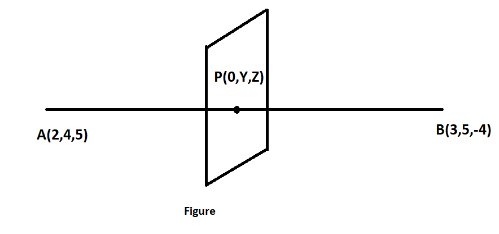
Find the ratio in which the $YZ$ plane divides the line joining A (2,4,5) and B (3,5, -4). Also find the points of intersection.
Answer
498.9k+ views
Hint:In this question we know that there is a point which divides a line into 2 unequal parts. We can assume its coordinates and apply the section formula. The ratio in which the point divides the given line segment can be found if we know the coordinates of that point.
Formula used:
\[x = \dfrac{{{m_1}{x_2} + {m_2}{x_1}}}{{{m_1} + {m_2}}} \\
\Rightarrow y = \dfrac{{{m_1}{y_2} + {m_2}{y_1}}}{{{m_1} + {m_2}}} \\
\Rightarrow z = \dfrac{{{m_1}{z_2} + {m_2}{z_1}}}{{{m_1} + {m_2}}} \]
Complete step by step answer:
According to the question there is a line AB with coordinates A (2,4,5) and B (3,5, -4) which is divided unequally into 2 parts, let the point of the plane that divides the line be P with coordinates (0, Y,Z) since the plane is Y-Z plane hence X coordinate will be 0. And the ratio in which it line segment AB will be divided be \[\lambda :1\] somewhat like this

The point P divides the segment into \[\lambda :1\]. Section formula is being used when A and B be the given two points \[\left( {{x_1},{y_1},{z_1}} \right)\] and \[\left( {{x_2},{y_2},{z_2}} \right)\] respectively, and P be the point dividing the line-segment AB internally in the ratio \[{m_1}:{m_2}\] then form the sectional formula for determining the coordinate of a point P is given by:
\[x = \dfrac{{{m_1}{x_2} + {m_2}{x_1}}}{{{m_1} + {m_2}}},y = \dfrac{{{m_1}{y_2} + {m_2}{y_1}}}{{{m_1} + {m_2}}},z = \dfrac{{{m_1}{z_2} + {m_2}{z_1}}}{{{m_1} + {m_2}}}\]
Here \[{m_1}:{m_2}\]=\[\lambda :1\]
Now putting the values
\[ \Rightarrow 0 = \dfrac{{3\lambda + 2}}{{\lambda + 1}}\](since the value of X is 0) - equation 1
\[\Rightarrow y = \dfrac{{5\lambda + 4}}{{\lambda + 1}}\,\,\,\,\,\, - eq\,2 \\
\Rightarrow z = \dfrac{{4\lambda + 5}}{{\lambda + 1}}\,\,\,\,\,\, - eq\,3 \\ \]
Solving equation 1 we get
\[\Rightarrow 3\lambda + 2 = 0 \\
\Rightarrow 3\lambda = - 2 \\
\therefore \lambda = \dfrac{{ - 2}}{3} \\ \]
Therefore, the ratio comes out to be \[ - 2:3\]. The point of intersection P can be calculated by putting the value of lambda in equation 2 and 3, all the coordinates of point P can be found. By solving the values come out to be (0,2,23).
Hence, the point of intersection is (0,2,23).
Note: There are two types of intersection that is internal section formula (if the point of intersection lies in between points A and B, as in this case), here above used section formula is used, there is another section formula that is external section formula that is \[x = \dfrac{{{m_1}{x_2} - {m_2}{x_1}}}{{{m_1} - {m_2}}},y = \dfrac{{{m_1}{y_2} - {m_2}{y_1}}}{{{m_1} - {m_2}}},z = \dfrac{{{m_1}{z_2} - {m_2}{z_1}}}{{{m_1} - {m_2}}}\] .
Formula used:
\[x = \dfrac{{{m_1}{x_2} + {m_2}{x_1}}}{{{m_1} + {m_2}}} \\
\Rightarrow y = \dfrac{{{m_1}{y_2} + {m_2}{y_1}}}{{{m_1} + {m_2}}} \\
\Rightarrow z = \dfrac{{{m_1}{z_2} + {m_2}{z_1}}}{{{m_1} + {m_2}}} \]
Complete step by step answer:
According to the question there is a line AB with coordinates A (2,4,5) and B (3,5, -4) which is divided unequally into 2 parts, let the point of the plane that divides the line be P with coordinates (0, Y,Z) since the plane is Y-Z plane hence X coordinate will be 0. And the ratio in which it line segment AB will be divided be \[\lambda :1\] somewhat like this

The point P divides the segment into \[\lambda :1\]. Section formula is being used when A and B be the given two points \[\left( {{x_1},{y_1},{z_1}} \right)\] and \[\left( {{x_2},{y_2},{z_2}} \right)\] respectively, and P be the point dividing the line-segment AB internally in the ratio \[{m_1}:{m_2}\] then form the sectional formula for determining the coordinate of a point P is given by:
\[x = \dfrac{{{m_1}{x_2} + {m_2}{x_1}}}{{{m_1} + {m_2}}},y = \dfrac{{{m_1}{y_2} + {m_2}{y_1}}}{{{m_1} + {m_2}}},z = \dfrac{{{m_1}{z_2} + {m_2}{z_1}}}{{{m_1} + {m_2}}}\]
Here \[{m_1}:{m_2}\]=\[\lambda :1\]
Now putting the values
\[ \Rightarrow 0 = \dfrac{{3\lambda + 2}}{{\lambda + 1}}\](since the value of X is 0) - equation 1
\[\Rightarrow y = \dfrac{{5\lambda + 4}}{{\lambda + 1}}\,\,\,\,\,\, - eq\,2 \\
\Rightarrow z = \dfrac{{4\lambda + 5}}{{\lambda + 1}}\,\,\,\,\,\, - eq\,3 \\ \]
Solving equation 1 we get
\[\Rightarrow 3\lambda + 2 = 0 \\
\Rightarrow 3\lambda = - 2 \\
\therefore \lambda = \dfrac{{ - 2}}{3} \\ \]
Therefore, the ratio comes out to be \[ - 2:3\]. The point of intersection P can be calculated by putting the value of lambda in equation 2 and 3, all the coordinates of point P can be found. By solving the values come out to be (0,2,23).
Hence, the point of intersection is (0,2,23).
Note: There are two types of intersection that is internal section formula (if the point of intersection lies in between points A and B, as in this case), here above used section formula is used, there is another section formula that is external section formula that is \[x = \dfrac{{{m_1}{x_2} - {m_2}{x_1}}}{{{m_1} - {m_2}}},y = \dfrac{{{m_1}{y_2} - {m_2}{y_1}}}{{{m_1} - {m_2}}},z = \dfrac{{{m_1}{z_2} - {m_2}{z_1}}}{{{m_1} - {m_2}}}\] .
Recently Updated Pages
Master Class 11 Economics: Engaging Questions & Answers for Success

Master Class 11 English: Engaging Questions & Answers for Success

Master Class 11 Social Science: Engaging Questions & Answers for Success

Master Class 11 Biology: Engaging Questions & Answers for Success

Class 11 Question and Answer - Your Ultimate Solutions Guide

Master Class 11 Business Studies: Engaging Questions & Answers for Success

Trending doubts
10 examples of friction in our daily life

One Metric ton is equal to kg A 10000 B 1000 C 100 class 11 physics CBSE

Difference Between Prokaryotic Cells and Eukaryotic Cells

1 Quintal is equal to a 110 kg b 10 kg c 100kg d 1000 class 11 physics CBSE

State the laws of reflection of light

Explain zero factorial class 11 maths CBSE




